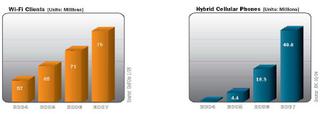
•The growth of wireless LAN (WLAN) or Wi-Fi clients and applications in the Enterprise market has created the need for the next generation in Wi-Fi architectures that provide the capacity, bandwidth and quality of service that user expect from their wired connections.
•As companies take advantage of the productivity gains from the wirelessly connected mobile worker, the demand for increased bandwidth (data rate) and capacity (number of users) will force WLANs to move from a shared medium to a more capacity-orientated architecture just as wired Ethernet did in the 1990's - unleasing the explosive growth in networking that followed.
•The WLAN market is fast approaching a similar point as wired Ethernet due to the explosive growth of Wi-Fi-enabled partable and handheld computers and hybrid cellular/Wi-Fi phones. The resulting mobility-centric applications that run on these devices will become mission-critical business enablers leaving legacy Wi-Fi network architectures incapable of operaing effectively.
•The growing interoperability between cellular and Wi-Fi networks was also cited as a major factor in the increase in demand for mobile VoIP/VoWiFi.
•According to IDC (International Data Corporation), shipment for WLAN access point are expected to reach nearly 25 million units by 2006 generating over $2.4 billion in revenue. These access point provide the critical link between the wireless client and the wired network allowing them to stay connected as they roam the corporate campus.
•In addition to the influx of "traditional" Wi-Fi computing clients which are expected to reach 60 million units in 2005, the number of application- specific devices such as Wi-Fi-enabled handsets and hybrid cellular phones is expected to reach 70 million units by 2007 - these new devices will be able to carry voice traffic over an available WLAN or the existing cellular network. This explosion in client connectivity along with force capacity to the forefront of deployment issues to resolve within the enterprise.
•Voice over Internet Protocol (VoIP) is receiving significant interest in the corporate IT marketplace today. For the first time, VoIP enables the convergence of enterprise LANs and traditional PBXs, replacing the heretofore separate worlds of datacom and telecom with a single, unified infrastructure and transport mechanism. The benefits of this convergence are substantial:
•• Reduced infrastructure investment. There is no longer any need to invest in separate installations for the corporate telephone system (PBX) and the corporate LAN. More significantly, there is no separate wiring; a single RJ-45 jack is capable of serving all the communication needs of an office.
•• Reduced operating costs. Modern corporations typically have dedicated high bandwidth pipes linking offices. Carrying intra-company voice as a small fraction of
•the LAN/WAN bandwidth lowers costs, and also allows long-distance toll avoidance in cities where the corporation has a point of presence.
•• Reduced maintenance costs. The converged network can be managed and maintained as a single entity from one management platform, lowering costs.
•• Advanced services. Combining the data and voice networking worlds enables a host of advanced applications to be supported, such as: unified directory and dialing services, convergence of voice mail and e-mail, number/extension portability, advanced conferencing, etc.
•Combining VoIP technology with Wireless LAN (WLAN) networking, to produce what is termed Voice over Wireless LAN (VoWLAN), enables still further integration and capability, including some powerful features not available in a purely wired world. For a start, the wires tethering the terminals disappear, and both data and voice can be delivered over radio links. This considerably reduces the traditional Category 5 wiring infrastructure used in today’s commercial buildings to connect users to wiring closet or data center switches. More importantly, it adds mobility to the equation; the services that users receive are no longer restricted by physical location, a fact of significant importance to today’s mobile workforce. Converting over to VoWLAN also raises the exciting possibility of true cellular and WLAN convergence, with seamless roaming handoffs within buildings, campuses, entire metro areas, and even worldwide. Besides enabling true number/extension portability, this holds the promise of minimizing costs while at the same time maximizing service capability. A VoWLAN network allows a scenario where low-cost WLAN access is used for high-bandwidth intra-campus operation (for both data and voice), and the cellular network is relied upon to provide continuity of service (at lower bandwidth) as users move out of the corporate coverage area. For all these reasons, VoIP and VoWLAN technologies are being rapidly deployed today. Network equipment is available from such large players as Cisco, SpectraLink, Hitachi, Samsung and Symbol. Standards are in place for voice transport over IP (RTP) and interoperable call setup and handoff protocols (H.323, SIP, Skinny, Megaco). IP gateways to corporate PBXs are fairly common, and true IP-PBXs (where both data and voice switching as well as transport is via IP) are just starting to appear on the scene.
Please take a look at the VoipWired Site. Your readers may be interested in the comprehensive page we have on the subject of "VOIP Distribution in a Home" and may be found at this address: http://www.voipwired.com/info/info_install_wiring.htm
ReplyDelete